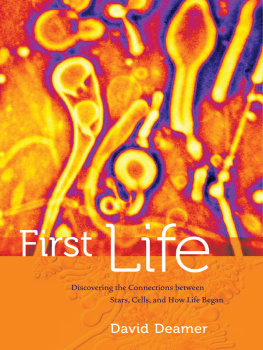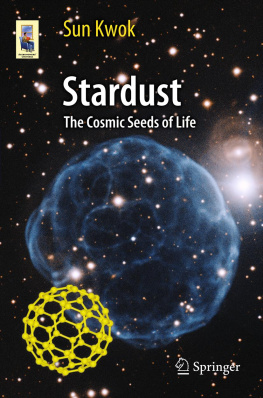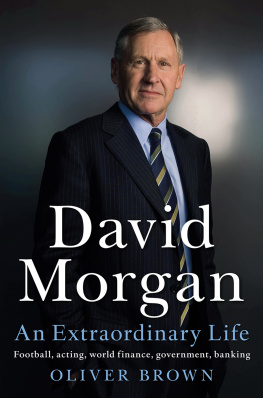ACKNOWLEDGMENTS
How life began is one of the outstanding questions of science, yet it is surprising how few researchers give it serious attention. This becomes abundantly clear if we consider scientific meetings dedicated to other disciplines. For instance, the annual meetings of chemists, biophysicists, and neurobiologists attract 10,000 or more researchers to cities like Chicago, Boston, and San Francisco, but the international meeting of origins of life researchers is lucky to have 500 participants show up in places like Florence, Oaxaca, and Montpelier. This means that virtually everything I discuss in this book comes from the work of just a hundred or so fellow scientists. Here I want to thank those friends and colleagues who have shared their knowledge with me over the past 30 years, who in a sense are coauthors of this book.
David Cornwell at The Ohio State University College of Medicine guided my doctoral research and introduced me to the wonders of lipid chemistry. I will not soon forget the pleasure of extracting pure phosphatidylcholine from the yolks of a dozen eggs, then seeing how it behaved on a homemade Langmuir trough.
Dan Branton and Lester Packer hosted my postdoctoral research at UC Berkeley and introduced me to a level of science that is unique to the great research universities of the world. With them, I learned about the structure and function of biological membranes, and I am still collaborating with Dan 40 years later in our studies of DNA.
Alec Bangham sparked my interest in the origin of life. In 1961, Alec discovered that phospholipid assembles into vesicles now called liposomes. I spent a sabbatical in Alec's lab at the Animal Physiology Institute in the tiny village of Babraham, a few miles south of Cambridge, England. One day while motoring down to London in Alec's Morris Mini, we came up with the following question: What lipid-like molecules were present on the prebiotic Earth that could assemble into the membranes required for the origin of cellular life? No one at the time had the slightest idea, but now, 30 years later, we can at least make an educated guess.
Tony Crofts hosted my first sabbatical leave in Bristol, England. Tony and I visited Alec to learn more about preparing liposomes, because we wanted to determine whether lipid vesicles could maintain pH gradients. Our study was inspired by a new idea called chemiosmosis that Peter Mitchell had published a few years earlier in Nature, so we also visited Peter, who had set up his own laboratory in a vast manor house just outside Bodmin. This was my first introduction to the extraordinary scientist whose ideas changed the way we think about bioenergetics.
Harold Morowitz and Franklin Harold both inspired me to think about how energy is captured by living cells today, and by extrapolation to life four billion years ago. Harold Morowitz wrote Beginnings of Cellular Life, the first book to focus on cellular compartments as an essential component of the earliest forms of life. Both Harolds wrote books on bioenergetics, describing with precision and clarity how energy flows through all of life.
John Oro was a true pioneer in advancing studies of life's beginnings. John discovered how adenine can be synthesized by the spontaneous polymerization of five HCN molecules, and was first to suggest that comets played an important role in delivering organic compounds to early Earth. John and I independently and simultaneously decided that we should add lipids to the list of prebiotic compounds. With our students as coauthors, we published separate papers describing how they can be synthesized in simulated prebiotic conditions, and then we coauthored a paper in 1980 that set the stage for involving lipids in origins of life studies.
Andrew Pohorille also studies lipids, particularly lipids in membranes and their dynamic motions. Andrew was kind enough to provide the computer images of lipid bilayers for this book.
Doron Lancet hosted my sabbatical at the Weizmann Institute in Rehovot, Israel, where he introduced me to an entirely new way to think about life's beginnings. With his student Daniel Segre, now at Boston University, we wrote a speculative paper entitled The Lipid World in which we imagined a living system with all the attributes of life, but no polymers.
Bob Hazen and Bernd Simoneit are geochemists who opened my eyes to the possible roles that mineral surfaces could play in the prebiotic chemical reactions required for the first forms of life. Bob wrote a wonderful book with the title Genesis: The Scientific Quest for Life's Origin, which was a constant inspiration to me as I thought about how to write this book.
Michael Mautner and Bob Leonard, Kiwi colleagues in Christchurch, hosted my visits to New Zealand. In one of my papers with Michael, we tested whether the soluble components of carbonaceous meteorites could provide a nutrient source for microbial and plant life. The amazing result is that they can! Bacteria and plants readily use atoms and molecules extracted from a meteorite that predates the age of the Earth.
Jerry Joyce and Jack Szostak are superb scientists who recognized early on that ribozyme catalysts in a cellular compartment are potential stepping stones toward the origin of life. Jack and Jerry independently showed how a system of enzymes and RNA could evolve, and Jack is now leading the way toward establishing a laboratory version of artificial life.
Then there are the authors of papers I have read with pleasure, learning from each. We regularly meet at Gordon Conferences, Astrobiology meetings, and ISSOL Congresses all over the world. Here they are, the colleagues who inspired many of the ideas that I discuss in First Life: Jeff Bada, John Baross, Steve Benner, Sherwood Chang, John Cronin, David Desmarais, Pascale Ehrenfreund, Jim Ferris, Nick Hud, Bill Irvine, Noam Lahav, Antonio Lazcano, Luigi Luisi, Lynn Margulis, Marie Christine Maurel, Stanley Miller, Leslie Orgel, Sandra Pizzarello, Carl Sagan, Bill Schopf, Steen Rasmussen, Jack Szostak, David Usher, Art Weber, and Richard Zare. Sadly, John C., Stanley, Leslie, and Carl are no longer with us in person, but their ideas are alive and will continue to influence our thinking for years to come.
I reserve particular thanks for Gail Fleischaker. In the 1980s, Gail was a graduate student working with Lynn Margulis, and her field of study was in the realm of philosophy of science. Gail was among the first to explore the idea introduced by Humberto Maturana and Francisco Varela, that life was unique in being autopoetic (self-initiating and self-sustaining) and that any definition of life must include bounded compartments. Gail and I had the pleasure of coediting a previous book called Origins of Life: The Central Concepts.
I also want to acknowledge the wonderful graduate students and postdoctoral associates who were brave enough to spend a few years in my lab. Why brave? Well, most grad students and post-docs expect to get a job when they complete their research, but there are virtually no jobs with the title Origins of Life Researcher. Despite this, all of them are gainfully employed, mostly in the academic world, but a few in industry and government labs. From A to Z, my special thanks go to Charles Apel, Gail Barchfeld, Ajoy Chakrabarti, Will Hargreaves, Dmitri Kirpotin, Sarah Maurer, Pierre-Alain Monnard, Trishool Namani, Felix Olasagasti, Sudha Rajamani, Sara Singaram, Roscoe Stribling, Sasha Volkov, and Helmut Zepik.
Not much happens in science without funding from research grants, and virtually all of my research described here was supported by grants from the NASA Exobiology and Astrobiology programs. And not much happens in publishing without agents and editors. Carol Roth found a home for this book at UC Press, and Blake Edgar shepherded the rough draft manuscript through a two-year process, gently guiding the writing task in helpful directions. I thank Kevin Plaxco, Jack Farmer, and Bob Hazen for their careful reading of the first draft and their kind comments.








